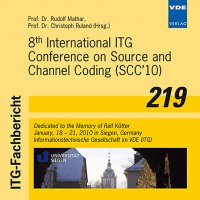A Cooperative Scheme for Shaping Degree Distribution of LT-Coded Symbols in Network Coding Multicast
Konferenz: SCC'10 - 8th International ITG Conference on Source and Channel Coding
18.01.2010 - 21.01.2010 in Siegen, Germany
Tagungsband: SCC'10
Seiten: 6Sprache: EnglischTyp: PDF
Persönliche VDE-Mitglieder erhalten auf diesen Artikel 10% Rabatt
Autoren:
Limmanee, Apirath; Henkel, Werner (Jacobs University, EECS, TrSys, Campus Ring 1, 28759 Bremen, Germany)
Inhalt:
This paper shows that LT-encoding at the source node and network coding at intermediate nodes cannot be applied together sequentially in binary erasure channels (BECs) without significant receiver performance degradation due to the distortion of the degree distribution in received LT-coded symbols. Two countermeasures are discussed. The first one is wise assignment of network codes, which totally eradicates the distortion in some specific, but not all, cases. The second one, being more universal, is a cooperation between the source and the relay nodes. The source introduces buffers for temporarily storing LT-coded output prior to transmission. Each buffer is a first-in-first-out (FIFO) queue associated with one outgoing edge of the source node. It is shown that under some conditions related to the degree of a particular LT-coded symbol, it is better to put that symbol into one buffer instead of another in order to keep the degree distribution distortion low. In addition, we paradoxically discover that the relay node, instead of always performing network coding, can improve the receiver performance by discarding some LT-coded symbols with a certain probability, since this will reduce the degree distribution distortion.


